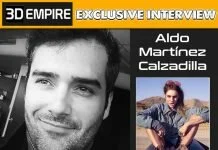3DE – First of all; we thank you for accepting this interview with us. Will you please shortly introduce yourself?
My name is Sefki. I’m a 3D Character Artist from London, and my specialism is in Photorealistic digital human work.
3DE – When and how did you begin to deal with 3d art?
Shortly after graduating from a degree in Mathematics in 2016, I was a little unsure of what career path I wanted to pursue. I considered going into Banking, but I knew I wanted to pursue something creative. A family friend gave me some 3D software to try out because of my love for drawing – it was an entirely new set of tools for me, but I became obsessed with it pretty quickly. It seemed to merge my passion for maths and art and felt like the perfect match for me.
3DE – Did you improve your 3d knowledge by online tutorials-books or did you ever take a 3d course?
I’m self-taught, of course with the aid of YouTube tutorials, which helped get me started. The first course I bought was Frank Tzeng’s likeness sculpting course on Gumroad around six months into starting 3D. Then, after a year of self-study, I enrolled at Kingston University, in London, to study Computer Animation. However, the class didn’t teach 3D portraiture, which was my main area of interest. So I continued to self-study and decided to use the assignments to focus on character art and better my portfolio.
Funnily enough, I’ve bought more courses in the past year than I did when I started. I think as you get better, you have a thirst for more knowledge and unlocking more potential.
3DE – Which software do you use?
I use Maya, ZBrush, Mari, Arnold for rendering and XGen for grooming. And on occasion, I use Mudbox.
3DE – What kind of workflow do you follow during the creation of a scene of yours?
If we’re talking hand-sculpted work, then I usually start with a base mesh for my portraits and sculpt in ZBrush. I mostly use Texturing XYZ skin maps in my work, which are projected onto the model in Mari to produce the displacement map. Typically, I employ projection methods for the diffuse as well with the addition of some hand-painting.
Subsequently, I use Arnold for building the skin shader and XGen to groom the hair. It’s a pretty standard pipeline.
With photogrammetry projects, the workflow still stands. However, there are some differences. For example, I use the software, Wrap3 to wrap the base mesh onto the scan and then project the scan information onto the model in ZBrush (followed by lots of clean-up and hand-sculpting).
3DE – What are your motivations while working on a new scene?
I enjoy making this kind of art. And I feel there are no limits to CG portraiture, so there’s always room to better myself with each portrait I make. I get excited to see if I can capture something more than just technical realism but something that has soul or personality. I don’t feel I’ve achieved this yet, so that’s what I aim for in my future works.
3DE – Do you ever lose your motivation and passion for 3d sometimes? If you do, how do you deal with it and get back into your mood?
Yes, it’s normal to feel demotivated, even when you love what you do. For me, it usually happens once I’ve finished a job. I have been very fortunate this year to have back-to-back projects; however, it can be challenging to switch from one to another so quickly. I need some time to rest and rejuvenate before I start anything new. Otherwise, I suffer from extreme burnout and have no desire to work. Since I’ve learnt this about myself, I make sure to book projects more accordingly – mental and physical health always trumps work.
3DE – When we check your works; we see that you mostly deal with famous-character likeness works. Is there a special reason for this?
I don’t have too many famous people in my portfolio. I’ve only just recently started doing my likeness portrait series. I think recreating famous people is a great way to challenge yourself because they are so recognisable. I also feel celebrity work impacts people in different ways. The responses to my portrait of Jim Carrey were particularly memorable – people could feel a real sense of him in the eyes. Something darker and not like his usual comedic persona, which was interesting.
3DE – How can you achieve this much accuracy to the real people on your character works?
I think accuracy comes from sheer practice. Jim Carrey was my first likeness in 2 years, and it took me ages to get it ‘right’. Method-wise, I tend to overlay trace-over diagrams to double-check proportions in ZBrush. But more importantly, I make sure not to spend all of my time in ZBrush but carry the model to Maya and back. The moment the character has colour, displacement, eyes, hair etc. the likeness evolves and changes, and your eyes refresh. Then you can discern what’s not quite right or what is working well.
3DE – How long does it generally take to create a character from scratch?
It depends on many factors. I can get a full portrait finished in probably 3-4 weeks from scratch. However, the age of the subject is a factor: older people require more sculpting (there’s more complex forms and wrinkles to sculpt). The hairstyle is a significant factor, long or curly hair takes a lot more time than shorter or simpler hairstyles, of course. There are other factors too, such as methods for creating the skin, the character’s outfit etc. So, in short, the time it takes varies from person to person.
3DE – Which one is more important? The software or the talent of the artist who uses that software?
“A good craftsman doesn’t blame his tools”. The software is negligible: people can do amazing things with various software. I’ve never really understood the obsession with what software artist’s use. I think there is a misconception that the software creates the artwork, when, in fact, it’s how the artist applies their talent to the software that creates the artwork.
3DE – What is your advice to newbies?
If you’re passionate about 3D and the industry, whether games/VFX/advertising etc. focus on what it is, you love to make. That’s what will get you working on it over and over again and striving to improve. For me, I just enjoyed working on photorealistic digital humans, so I spent all my time focused on that. Now my job is to make them.
Ultimately, every artist wants a portfolio that represents them and is something they are proud of – strive for that.







